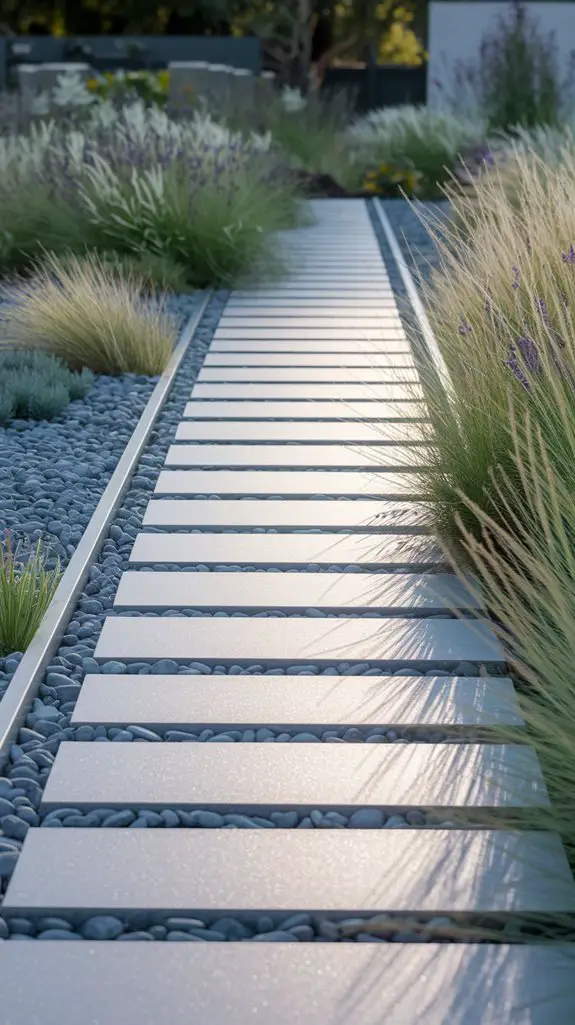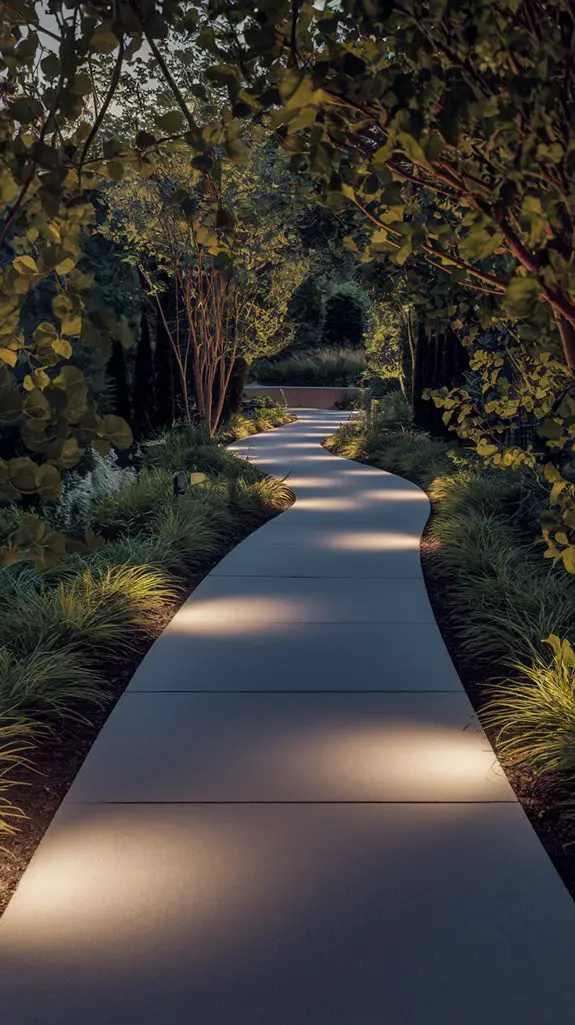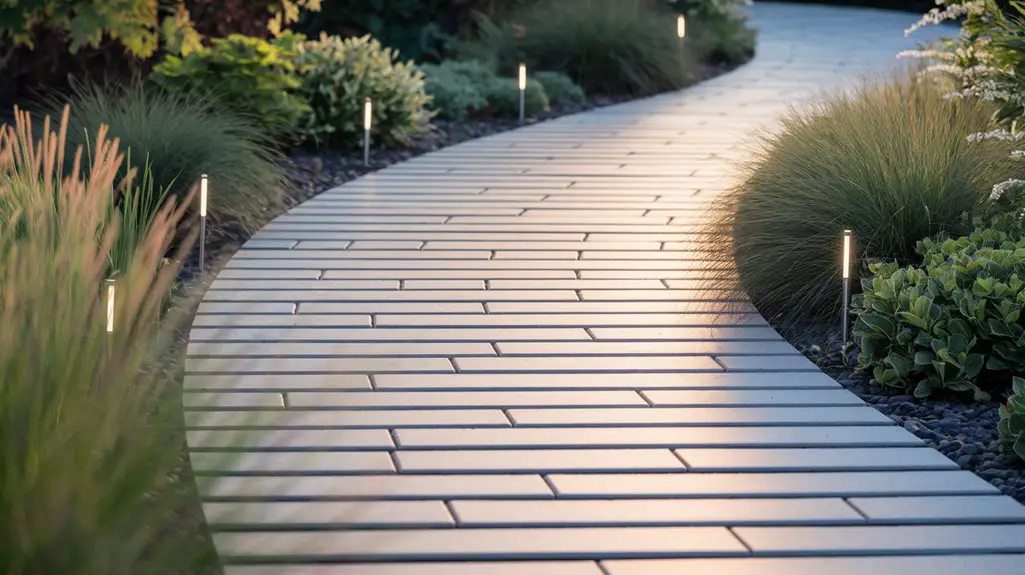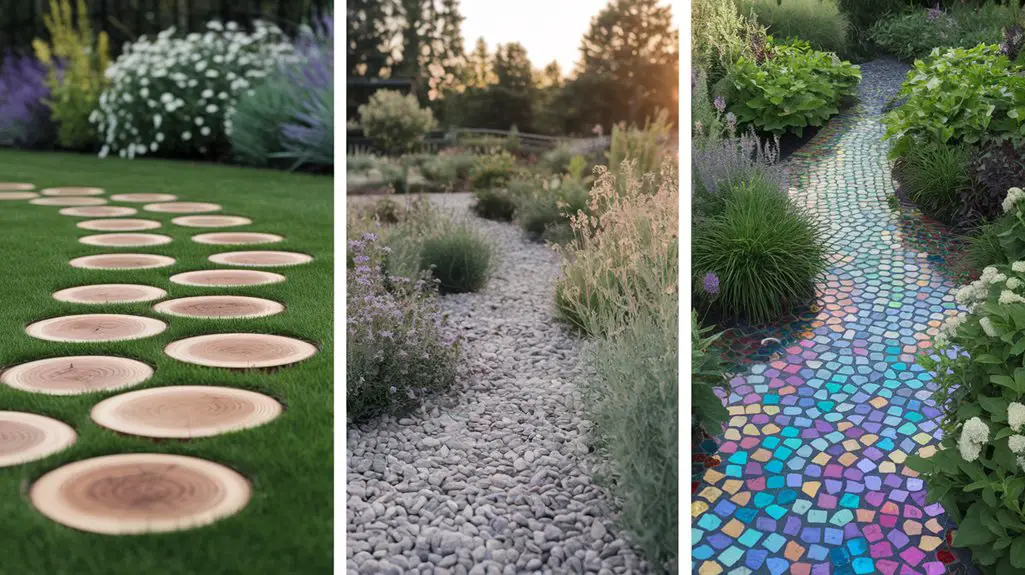Modern garden walkways no longer serve as mere functional elements but have evolved into architectural focal points that define your outdoor space’s character. You’ll find that well-designed paths create visual flow, directing attention to featured landscape areas while establishing clear navigation throughout your garden. By selecting contemporary materials and innovative layouts, you’re not only enhancing accessibility but also elevating your property’s aesthetic appeal—transforming an ordinary garden into a cohesive outdoor living environment that mirrors your personal style.
Contemporary Walkways: Merging Functionality With Aesthetics
While traditional garden paths have served primarily functional purposes, contemporary walkway designs elevate these essential elements into aesthetic statements.
You’ll find that modern approaches prioritize seamless integration with your landscape’s overall design language.
Materials selection becomes critical in this merger of form and function. Opt for concrete pavers with clean lines for minimalist gardens, or choose composite decking for warmth against modern architecture.
The connection points—where walkways meet garden beds or patios—deserve particular attention, as they establish visual rhythm throughout your outdoor space.
Consider how light interacts with your walkway’s surface. Recessed LED fixtures can transform a daytime utilitarian path into an evening design feature, emphasizing texture and creating depth perception that enhances spatial awareness without sacrificing aesthetic integrity. Proper pathway lighting is essential to ensure safety and highlight the walkway’s unique design elements.
Material Innovations for Modern Garden Pathways

The evolution of garden walkway materials has accelerated dramatically in the past decade, offering homeowners unprecedented options beyond traditional stone and brick.
Composite decking, made from recycled plastics and wood fibers, now provides weather-resistant, low-maintenance pathways with the aesthetic appeal of natural wood.
Permeable concrete pavers represent another breakthrough, allowing rainwater to filter through rather than causing runoff.
These eco-friendly solutions help maintain your garden’s natural hydration cycle while reducing puddles.
For dramatic visual impact, consider photoluminescent aggregates embedded in resin-bound surfaces that absorb daylight and emit a subtle glow after dark.
Similarly, glass-infused concrete offers unexpected reflective properties that capture and amplify ambient light, creating striking effects as you traverse your garden’s pathways.
Lighting Elements to Enhance Your Walkway Design

How effectively you illuminate your garden walkways determines not only nighttime functionality but also defines your outdoor aesthetic. Integrate recessed LED path lights for energy efficiency and minimal visual intrusion during daylight hours.
Position fixtures at consistent intervals—typically 8-10 feet apart—to create rhythmic pools of light that guide movement.
Consider color temperature carefully: 2700-3000K warm white enhances natural elements while 4000K cool white accentuates contemporary materials. Motion-activated systems provide security benefits while reducing energy consumption.
For sustainable solutions, implement solar-powered options with photovoltaic cells that store daylight energy. Smart lighting systems can also be integrated to offer versatility and control over your outdoor ambiance.
Uplighting surrounding vegetation creates dramatic shadow play, while downlighting from trees delivers a moonlight effect. These techniques transform your walkway from mere transit space into an immersive nighttime experience.
Geometric Patterns and Minimalist Approaches
Geometric precision defines contemporary garden walkways where clean lines and mathematical order create visual impact with minimal elements.
Consider incorporating repeating squares, rectangles, or hexagons using concrete pavers with narrow grass joints to establish rhythm and structure. These patterns transform functional paths into architectural statements.
Minimalist approaches favor restrained material palettes—often limiting choices to just two contrasting elements like pale concrete against dark gravel.
This deliberate restriction heightens visual tension while maintaining cohesiveness. For maximum effect, align walkway angles with your home’s architectural geometry, creating intentional sight lines that guide movement through the space.
You’ll find that these designs require meticulous planning but deliver sophisticated results that complement modern architecture and emphasize spatial clarity without overwhelming your garden’s natural elements. Additionally, decorative gravel walkways can enhance the overall aesthetic while providing effective drainage solutions.
Sustainable Options for Eco-Conscious Homeowners
Environmentally conscious garden walkways have evolved beyond mere aesthetics to address critical sustainability concerns while maintaining design integrity.
Today’s eco-friendly pathways incorporate permeable materials that reduce runoff, utilize recycled components, and minimize environmental impact throughout their lifecycle. Additionally, using eco-friendly mulch options can enhance the overall health of your garden while complementing your walkway design.
- Permeable pavers – These allow rainwater to filter naturally into the ground, reducing erosion and supporting groundwater replenishment while preventing puddles on your walkway surface.
- Recycled composite materials – Made from post-consumer plastic and wood fibers, these durable options require minimal maintenance and won’t leach chemicals into your soil.
- Locally-sourced natural stone – Reduces transportation carbon footprint while providing timeless durability; when set in sand or gravel rather than concrete, these walkways remain fully recyclable.
Weather-Resistant Walkway Solutions for Year-Round Appeal
Creating a garden pathway that withstands diverse weather conditions requires careful material selection and installation techniques that balance durability with aesthetic appeal.
You’ll achieve peak performance by selecting materials with freeze-thaw stability, such as porcelain pavers, engineered composite decking, or polymer-bonded gravel. These options resist cracking, heaving, and color fading while maintaining structural integrity through seasonal shifts.
Proper drainage implementation is essential—incorporate a slight crown or cross-slope (1-2%) to direct water away from the walking surface. For regions with heavy precipitation, consider permeable solutions that allow water infiltration rather than runoff. Low-maintenance garden walkway designs are particularly beneficial for homeowners looking to minimize upkeep while still enjoying a beautiful landscape.
Modern sealants with UV inhibitors extend the lifespan of concrete or natural stone pathways, while reinforced edging prevents erosion and maintains clean lines throughout the changing seasons.
Integrating Technology Into Garden Path Designs
While traditional garden walkways fulfill basic navigational purposes, today’s smart path designs incorporate innovative technologies that transform ordinary routes into interactive, functional experiences.
You’ll find these tech-enhanced pathways elevate both aesthetics and practicality through seamless integration with your home’s automation systems.
- Install solar-powered LED lighting with motion sensors that illuminate your path when detected, conserving energy while providing nighttime visibility.
- Implement weather-responsive heating elements beneath walkway surfaces to melt snow and prevent ice formation during winter months.
- Integrate QR codes within decorative pavers that link to plant information, garden history, or maintenance schedules when scanned with your smartphone.
These technological enhancements don’t just modernize your garden—they create responsive outdoor environments that adapt to your needs throughout changing seasons. Additionally, incorporating unique stone walkway designs not only enhances the visual appeal but also complements the functionality of modern garden paths.
Complementing Your Home’s Architecture With Coordinated Walkways
Harmonious design principles dictate that your garden walkways should visually connect with your home’s architectural style rather than existing as disconnected elements within your landscape.
This cohesion creates visual continuity that enhances your property’s aesthetic value and spatial flow.
For contemporary homes, implement clean-lined concrete pavers with minimal joints or poured concrete with architectural scoring patterns.
Mid-century modern architecture pairs well with offset rectangular pavers interspersed with gravel or groundcover.
Traditional homes benefit from herringbone brick patterns or natural flagstone that echo existing masonry elements.
Consider replicating your home’s material palette in your walkway design—matching brick types, incorporating similar stone varieties, or selecting complementary concrete finishes.
Coordinate walkway width proportions with your home’s scale to maintain balanced visual rhythm throughout the property.
Conclusion
Your modern garden walkway isn’t merely a path—it’s an architectural statement that transforms your outdoor space. Studies show that well-designed walkways can increase property values by up to 20% while reducing landscape maintenance costs. By selecting contemporary materials, innovative lighting, and sustainable solutions that complement your home’s design language, you’ll create a cohesive, functional outdoor experience that seamlessly shifts between garden features.



